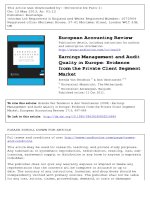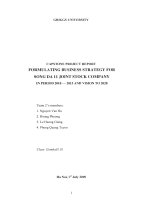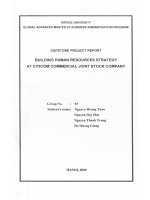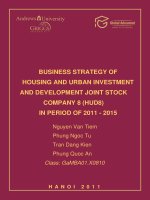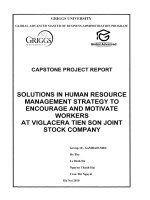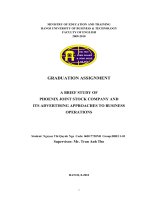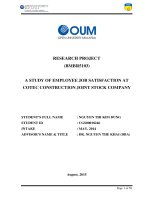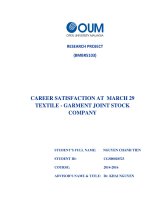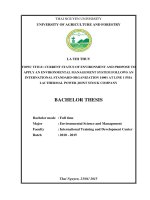PRODUCTION MANAGEMENT AND PRODUCT QUALITY IMPROVEMENT AT x20 JOINT STOCK COMPANY
Bạn đang xem bản rút gọn của tài liệu. Xem và tải ngay bản đầy đủ của tài liệu tại đây (2.74 MB, 105 trang )
Paris Graduate School of Management
Thai Nguyen University
INTERNATIONAL EXECUTIVE
MASTER OF BUSINESS ADMINISTRATION PROGRAM
THESIS TITLE:
PRODUCTION MANAGEMENT AND PRODUCT QUALITY
IMPROVEMENT AT X20 JOINT-STOCK COMPANY
FOCUS ON:
IMPROVE THE MATERIALS MANAGEMENTAT
X20 JOINT STOCK COMPANY
Student’s name:
NGUYEN TRUNG HIEU
Intake I
2012
Nguyen Trung Hieu – Class MBA.B01
DETAILED OUTLINE OF THESIS
INTRODUCTION................................................................................................. 01
1. The need for research........................................................................................ 01
2.
Research issues.............................................................................................. 03
3.
Study objectives............................................................................................. 03
4.
Object and Scope of the study...................................................................... 04
5.
Overview of research issues.......................................................................... 04
6.
Research methodology.................................................................................. 04
7.
The new point of the essay............................................................................ 05
8.
Structure of the essay.................................................................................... 05
DEFINITIONS....................................................................................................... 07
CHAPTER 1. GENERAL ISSUES OF MATERIALS MANAGEMENT........ 08
1.1
The concept and role of materials management...................................... 08
1.1.1 The concept of materials management....................................................... 08
1.1.2 The role of materials management............................................................. 08
1.2
Contents of materials management.......................................................... 10
1.2.1 Identify materials needs.............................................................................. 10
1.2.1.1Norm of materials consumption................................................................. 10
1.2.1.2 Material needs of the enterprise................................................................ 11
1.2.2 Planning for materials procurement.......................................................... 13
1.2.3 Materials reserve at the enterprises............................................................ 15
1.2.3.1Reserve management system....................................................................... 16
1.2.3.2The types of materials reserve in the production........................................ 16
1.2.3.3 General principles of reserve management............................................... 17
1.2.3.4 Reserve level for production....................................................................... 18
1.3 Models of materials management, technical analysis and control charts.. 21
1.3.1 Optimum storage model (EOQ) .................................................................. 21
i
Nguyen Trung Hieu – Class MBA.B01
1.3.2 Technique of ABC analysis............................................................................ 23
1.3.3 Graph for materials quality control............................................................ 25
1.3.3.1Checking...................................................................................................... 25
1.3.3.2 Process control............................................................................................ 25
1.3.3.3 Control chart............................................................................................... 26
1.4
Analysis of the materials management..................................................... 27
1.4.1
Analysis of the status of materials supply.................................................. 27
1.4.2 Analysis of materials reserve status........................................................... 28
1.4.3 Analysis of tatus of materials using........................................................... 29
CHAPTER 2: ACTUAL STATUS IN MATERIALS MANAGEMENT AT X20
JOINT STOCK COMPANY................................................................................ 31
2.1
Overview of X20 JSC................................................................................. 31
2.1.1 Overview of the process of formation and development............................ 31
2.1.2
Business tasks............................................................................................. 32
2.1.3 Structure of X20 Joint Stock Companies.................................................. 33
2.1.4 Functions, the basic tasks of the management department....................... 34
2.1.5 Characteristics of business organization.................................................... 35
2.1.5.1Structure of business organization............................................................. 36
2.1.5.2 Functions and tasks................................................................................... 36
2.1.6 Characteristics of technology process of production................................. 37
2.2 General introduction of materials management.......................................... 39
2.2.1 Characteristics of the organization of materials management.................. 39
2.2.2 Classification, quality standards, maintenance supplies........................... 40
2.2.2.1 Classification of materials......................................................................... 40
2.2.2.2Quality standards........................................................................................ 43
2.2.2.3 Preservation and materials input and output........................................... 43
2.3
Work of materials supply plan................................................................. 49
2.3.1 The work of production planning and identify the needs of materials...... 49
2.3.2 Determine the quantity of materials needed to buy................................... 51
ii
Nguyen Trung Hieu – Class MBA.B01
2.3.3 Cycle of materials purchase........................................................................ 52
2.4
Analysis of the use of materials................................................................. 53
2.4.1 Analysis of the use of materials in general................................................. 53
2.4.2 Analysis of the supply situation................................................................... 55
2.4.3 Analysis and inventory reserves.................................................................. 55
2.4.4 Analysis of the use of materials.................................................................. 56
2.5
General comments on the management of materials of X20 JSC......... 59
2.5.1 Strengths of the materials management..................................................... 59
2.5.2 Limitations in the materials management.................................................. 60
CHAPTER 3. SOME RECOMMENDATIONS TO ENHANCING THE
MATERIALS MANAGEMENT......................................................................... 61
3.1
Measures to enhance the supply materials for the Corporation X20... 61
3.1.1 Search for new sources materials’ supply to add or replace part of
imported materials, increase business efficiency.................................................. 61
3.1.2 Completing the purchasing materials contracts......................................... 63
3.1.2.1 Base problems............................................................................................. 63
3.1.2.2 The solutions.............................................................................................. 63
3.1.3 Review regularly the Company’materials suppliers. ................................. 64
3.2
ABC method in classifying the inventory................................................. 68
3.2.1 Basis and methods....................................................................................... 68
3.2.1.1 Basis of measures....................................................................................... 68
3.2.1.2 Content of the solutions............................................................................ 68
3.2.2 Evaluation of the effectiveness of ABC method......................................... 70
3.3
Applicating the EOQ model to calculate optimally the reserve materials
for production........................................................................................................ 71
3.3.1 Basis of measures........................................................................................ 71
3.3.2 Content of the measures.............................................................................. 71
3.3.2.1 Based on the demand plan calculating the required reserves materials.. 71
3.3.2.2 Making the total reserves cost function and optimum production order.. 71
iii
Nguyen Trung Hieu – Class MBA.B01
3.3.3 Assess the effectiveness of the application EOQ model to the Company’s
storage management.............................................................................................. 80
CONCLUSION..................................................................................................... 81
REFERENCES...................................................................................................... 82
APPENDIX............................................................................................................ 83
iv
Nguyen Trung Hieu – Class MBA.B01
ACKNOWLEDGEMENTS
After a period of study and research in PGSM's MBA program, I have gained
a lot of useful knowledge, with highly practical applications for current job. Over
here, I would be deeply grateful to the teachers’s PGSM's MBA program. By his
love and passion for this job, the teacher imparted to us the precious and practical
knowledge.
In particular, I would like to thank a profound teacher, Dr. Tran Van Hung,
director of the center of Small and Medium Enterprise Development National
Economic University for enthusiastic guidance and helping me completely this
thesis. Sincerely, thank the officials and leaders Corporation X20 for feedbacking
and helping me completely this thesis.
Graduate students class MBA.B01,
Nguyen Trung Hieu.
v
Nguyen Trung Hieu – Class MBA.B01
INTRODUCTION
1.
The need for research:
Vietnam's economy is in long-term crisis, the dual impact of the recession:
inflation lasted from 2008 to 2011 and deflation six months of 2012 was the
depletion of "resistance"of all businesses. In 2008, Vietnam inflation began to rise
along with interest rates rise (lending rates sometimes up to 21-25% / year)
increased the input costs of the business. Economic picture "brighter" than in 2009
thanks to the economic stimulus package of the government but it is also the cause
of inflation in 2010-2011. The government's interest supporting capital is provided
directly to businesses through commercial banking system, the government does not
take measures to withdraw funds when the economy has stabilized. Inflation,
interest rates remain high that impact business input costs to be high, resulting in
high production costs. People's income growth rate lower than the price increase,
people tend to save, limited spending, this reduces the purchasing power of the
market. Production of high prices, sales difficulties, therefore, the enterprises faced
with problems of cutting costs to reduce costs. In the first eight months of 2012,
recognizing the difficulties of the enterprises, government and the State Bank has
strong measures to reduce the interest rate to a reasonable level (12% / year) to help
businesses overcome difficulties.
Along with the efforts of government, businesses are trying to overcome
difficulties, now take all measures to cut costs in order to maintain business
operations and improve the competitiveness of enterprises. One of the measures
used to reduce the cost of business is the management of materials at reasonable
levels, reduce inventory costs at the maximum. Materials management consists of
various stages: supply, storage, quality control and use of materials.
In the context of the current economic difficulties, the textile industry faced
stiff competition at the domestic market and international market. As announced by
the Vietnam Textile and Apparel Association (Vitas), 2011 textile trade surplus of $
6.5 billion, up $ 1.5 billion compared to 2010 and raise the localization rate of 48%.
Page 1
Nguyen Trung Hieu – Class MBA.B01
This is a remarkable achievement in the context of purchasing power in the world
market fell, exports of some other staples of Vietnam fell. However, the textile
industry make great efforts to reduce dependence on imported raw materials (about
85%). The domestic market has great potential due to the tastes of consumers
believed in Vietnam textile, textile enterprises see the domestic market as a cure in
crisis period. As announced by the Ministry of Industry and Trade, in 2011, Vinatex
revenue from the domestic market reached 17,200 billion, growth of 15% or the
products "Made in Vietnam" to be choosed by consumers. Vinatex target towards
the domestic market growth in 2012 is 18-20%.
The first target set in 2012 for Vietnam's garment and textile exports is to
conquer the $ 19 billion mark. Results of the first seven months of 2012, the total
export value of $ 9.2 billion, just over $ 1.3 billion on average every month . Due to
the difficult situation of the global economy, the textile industry reduced the
industry's export target to $ 17 to 17.5 billion ($ 2 billion lower than the first plan
of the year). The reason is that the enterprises of the textile industry faced with a
lack of capital, lack of raw materials and input costs increase, while output prices
decline. Compared with the same period last year, exports of textile products is
reduced by 20%. Price decreased sharply, but not easy to find export contracts. The
number of small businesses (in textiles industry) face difficulties in finding the
output market.
X20 stock company is a unit of the textile industry, the Company's products:
Easter, uniforms, clothes for Defense; shirts, jackets, attire; exports clothes(jackets,
motorcycle racing clothes, etc.); fabric, socks, towels, etc. in the context of the
economic crisis, the textile industry goes down, the raw material market
fluctuations, increases in input costs, stiff competition, therefore, need to reduce
costs as a precondition for reducing production costs, enhance the competitiveness
of products in the domestic and international market. And one solution to cut
production costs are materials and resource management of the Company by means
of: construction of additional channels providing inputs, looking for new materials,
Page 2
Nguyen Trung Hieu – Class MBA.B01
building effective material norms, ... at the same time ensuring that the production
process is ongoing.
Materials management, in addition to factors such as the search for new
materials, new suppliers, the quantity of reserves, the volume of orders ... the
company should pay attention to the quality control of materials. Strictly control the
quality of inputs is one of the important measures to improve product quality,
reduce defect rates leading to lower production costs, increase competitiveness of
the products.
Comes from the state of the economy, the textile industry and in the case of
materials resource management of the Corporation X20, combined with the
knowledge to be learned, I have decided on a topic for my essay, "Improve the
materials management at X20 Joint Stock Company ".
2.
Research issues:
The essay focuses on the research of materials management at X20 Joint Stock
Company in the context of the current economic crisis, including the input stage,
input quality assessment, inventory and monitor inventory quality to ensure efficient
and continuous production activities, as well as the base for products price decrease.
3.
Study objectives:
Implementation of the essay with the following objectives:
- Analysis of the current situation and identify shortcomings in the materials
management at X20 Joint Stock Company to identify measures to improve the
materials management.
- Measures to search for new materials, new suppliers and evaluation of raw
materials and suppliers to ensure enough materials for production and business
processes continuously, without interruption.
- Apply ABC analysis techniques to arrange the materials from warehouse to
increase utilization factor, reduce time for materials transitting, create convenience
in the course of inspection, control and monitoring materials.
Page 3
Nguyen Trung Hieu – Class MBA.B01
- Control the parameters of the raw materials from which to make
recommendations for vendors and production units used materials. This goal helps
stable production and have timely solutions for each shipment.
- Application suitable materials reserve model to calculate the number for the
orders of raw materials and the appropriate time of order to minimize the costs of
orders, increase efficient use of working capital.
4.
Object and Scope of the study:
a/ Objects of study:
The work of materials management at X20 Joint Stock Company.
b/ Scope of research:
-
Time of research from January, 2011 to June, 2012.
-
Space research at the garment factory 3 of X20 JSC.
5.
Overview of research issues:
Essay is to explore and gather previous studies on materials management.
Previously there were some research essays on materials management and came up
with some solutions to improve the efficiency of materials management. Due to the
complex nature of the materials management, therefore, in various economic
fluctuations, it will have different materials management process to ensure business
continuity, minimize waste, cost savings, improve the competitiveness of products.
In difficult economic context, competition in the textile industry has put all
textile firms facing cost-cutting problem and from that the textile enterprises have to
improve their management. And one of the issues that need to pay attention is the
source of materials management. With the urgency of doing so, the research essay
focuses on the current materials management of X20 JSC, which give some
solutions to improve the management of materials, improving efficient production
and business activities.
6.
Research methodology:
Page 4
Nguyen Trung Hieu – Class MBA.B01
The essay uses syn methods in the research process: analytical method,
comparative method, indicators method, statistical method, assessment method,
optimization method.
Secondary data are taken from the production report and business activities of
the Company. This data is used to analyze and compare the use of that materials is
to use the materials norms compared to the actual use of materials, the supply of
materials from suppliers ...
ABC analysis techniques are used to classify the materials stored in the
warehouse of the company. This method requires information on the rate of use of
materials per unit of product, the value of each type of materials, classification of
main materials and auxiliary materials.
Have panel of suppliers assessment through standards such as quality stability
of materials, price standard , delivery time. Technical standards or the parameters of
materials that to be highest evaluated, then to the criterias such as price or delivery
time.
Optimization method(EOQ) is applied in the analysis of quantirty of one
order, time to order to ensure the lowest purchase cost. The data to be collected are:
purchase costs, warehousing costs, ordering costs, storage needs.
7.
The new point of the essay:
The essay focuses on the analysis and assessment of the state of materials
management at X20 JSC. This essay addresses the problems existing in materials
management at X20 JSC, find out the causes of these problems and come up with
the remedy.
8.
Structure of the essay:
In addition to the preface, table of contents, general conclusions and a list of
references, the essay is structured into 3 Chapters.
Chapter 1: The general theoretical issues of materials management
Page 5
Nguyen Trung Hieu – Class MBA.B01
Chapter 2: Status of materials management at X20 JSC.
Chapter 3: Recommendations to improve the management of materials in
X20 JSC
Page 6
Nguyen Trung Hieu – Class MBA.B01
DEFINITIONS
- The process of sewing techniques: is a tables which records time manufacturing
and used equipment for producing.
- Hard Form: product’s details is printed from the software to paperboard.
- Soft form: the product’s details designed on paper.
- Mini Template: The details collection of a product is zoomed down by a certain
percentage.
- Template: is the process of arranging the product ’s details on a certain fabric
size.
- Cutting samples workshop: copy form
soft form to hard form and make
samples.
- Garment samples workshop: making a sample product according to customer
requirements.
- MODEL: detailed statistical tables of a product.
- Colour Table: The table shows the color of all the details on a product.
- List: clearly document about types, the number of materials in each code
provided by the company.
Page 7
Nguyen Trung Hieu – Class MBA.B01
CHAPTER 1. GENERAL ISSUES OF MATERIALS MANAGEMENT
1.1
The concept and role of materials management
1.1.1 The concept of materials management
Materials management includes all activities in order to control the
movement of the flow of materials in the business cycles, which is the identification
of materials requirement, materials source planning, procurement organizations
and management activities of reserve materials source, settlement, analysis and
evaluation process.
The main tasks of materials management:
- Defining the minimum demand of materials for production and business
activities of company to help these activities to be ongoing .
- Planning for materials procurement , daily, monthly and quarterly.
- Prepare materials and technical orders and signing supply contracts with
suppliers; follow and monitor the implementation of the signed contract.
- Searching for additional sources of materials to fully meet the needs of the
company and looking for other source of materials in order to create competitive
advantage for suppliers.
- To receive materials in quantity, quality and have good materials storage.
- Monitor regularly the status of using, reserve materials for the production
process to be ongoing and in any case must have specific preventive measures and
timely to ensure the production not be interrupted by lack of materials.
- Ensure materials according to limitation for factories and other departments
in company and regularly check the use of the materials to be delivered.
- Record materials and monitor - assess the quality of materials and report to
ensure materials for company.
1.1.2 The role of materials management
Production process of the enterprise is the process that company uses
workers through labor tools to impact on labor subjects, basic change in shape, size,
Page 8
Nguyen Trung Hieu – Class MBA.B01
physical chemical properties of the labor objects to create new products to meet the
diverse needs of people.
In the manufacturing process, materials play a very important and
indispensable factor for the formation of the production process to create wealth.
Materials as tools of labor, they are expressed in the form of machinery and
equipments, tools, at that time materials are characterized to be used repeatedly
several times during the production cycle. Materials under this form, they are
gradually transformed into products through depreciation of fixed assets and at this
time materials are major factor promoting increased labor productivity, improve
product quality, cost savings.
Materials serve as the object of labor, they manifest in the form of raw
materials involved from the beginning to the end of the production cycle. With this
role, the material is transfered one time into product and then using materials
effieciently will directly affect the efficiency of production and business process.
Reasonablely using of materials and savings will help reduce the costs of capital in
business.
Materials are guaranteed in full, uniform, quality is the prerequisite condition
that decides the ability of reproduction of the enterprise. Materials are parts that
directly create products, which accounted for about 60-70% of the production costs,
so the materials play a very important role in reducing business costs and is the
basis to reduce production costs.
From the above role of materials shows the great significance of the activity
to ensure materials for production; materials must fully synchronized and timely to
ensure continuous production process. With any irrationality in the supply of
materials such as inadequate materials, not ensure quality ... will disrupt production
activities, this is the cause of a violation of the economic relationship to be
established between business partners and leading to the financial loss.
Ensure good materials for the production process to meet the requirements
for the quantity, quality and correct specifications, type, timely and synchronization.
Page 9
Nguyen Trung Hieu – Class MBA.B01
This directly affect the productivity of the enterprises, the quality of products, to the
rational use and saving materials, production efficiency, the financial situation of
the enterprise and furthermore to the existence and development of the enterprise.
1.2
Contents of materials management
1.2.1 Identify materials needs
1.2.1.1Norm of materials consumption
Norm of materials consumption is the maximum amount of materials to be
needed to produce a unit of product in a given economic and technical condition.
The method to establish norms of materials
Experienced laboratory method
In fact this method is based on the experimental results in combination with
the experience gained in the production process to build the plan period. Depending
on the characteristics and properties of materials and production characteristics of
the product to determine the content and scope of the experiment, details as follows:
- Testing in production (experimental): that is, conducting trial production in
the actual manufacturing conditions to collect and analyze data and draw
conclusions about the plan for plan period.
- Experiments in research facilities (laboratories): ie conducting trial
production within laboratory, find out the consumption rate for plan period in
permit conditions of the facilities.
Analytical method to calculate
The essence of this method is to calculate the level for each product based on
the study of key factors influencing the cost of materials, calculate all materials
consumed in production and sum up for the plan . When conducting this method, it
requires meticulous research of production technology process and financial
statistics report on the use of materials. Steps:
- Collect research and analysis of original documents including: State
standards on product quality, product design and manufacturing technology process,
Page 10
Nguyen Trung Hieu – Class MBA.B01
research the actual conditions in equipment and technical conditions of production
and technical standards, the reports on the use of materials of the previous year.
- Identify each component of consumption: Based on production technology
to be identified, check the progress of the method, quality control, product
structures and in turn determine the choice of product weight or useful waste
generated from an initial amount of materials.
- Identify technology waste , identify materials waste caused by subjective
factors such as the unreasonable organization of production ...
- Sum up the materials norms for one product:
Based on the waste components to be identified above, we synthesized the
level (M1) according to the following formula:
M1 = P + H 1 + H2
In which:
M1 M1 is the consumption level for plan period
P is useful waste
H1 is materials waste related to production technology
H2 is materials waste related to the level of production and
business management .
The materials norms determined by this method show the details of the cost
quantities. Therefore, the results determine the materials norms that ensure the
advanced factor.
1.2.1.2 Material needs of the enterprise
Material needs are the needs for raw materials, machinery and equipment to
perform certain business tasks.
Method of determining materials needs
Materials needs to be based on the use of materials for a product unit and
product output.
Vncj =
(1)
Page 11
Nguyen Trung Hieu – Class MBA.B01
In which:
Vncj is materials requirement of type j of the planning period ;
Qi is the product i to be produced during the planning period
Vdmij is the consumption rate of materials J for product i
n is the number of items produced
Cost of materials type j:
Cj = Vncj.Pj = ∑QiVdmij.Pj(tiền)
Total costs of materials:
Cvt =
Pj
j=
=
Price of materials type j
1.n
is the number of types of materials of company
For manufacturing enterprises, in addition to the materials listed above,
enterprises need to identify additional needs for repairment of equipment, plants and
materials needs for scientific research,materials needs for construction and storage
needs of the enterprises. These materials needs should be specified at the beginning
of the business (usually at the begginning of the year) and must be clearly
quantified, give a specific time to build financial planning accurately and
efficiently.
Sources to meet the needs of materials for enterprises
Inventory sources at beginning
Due to the time of plan for materials procurement for production at a time
when the yearly report does not end yet, the inventory at the beginning period is
determined by the estimate, details as follows:
Dđk = Dtt + Nh – X
In which:
Dđk is estimated inventory at the beginning of planning period.
Dtt is the actual inventory at the time of planning.
.
Page 12
Nguyen Trung Hieu – Class MBA.B01
Nh is the estimated amount of input since the time of planning to the
end of the yearly report.
X is the estimated amount of output at the same time
Sources originating at the internal of the enterprise
When conducting business activities, market participants have a "power", a
particular advantage and fundamental differences between the enterprises that are
"internal strength". Every enterprise has its own potential and not all the enterprises
will develop that potential.
And materials resources mobilized by the enterprises thanks to their intrinsic
capability is to show the enterprises develop "internal strength", available potentials
of themselves, source materials include:
- Materials sources have been organized by the enterprises from production,
processing, gathering materials.
- Source materials to be back and reuse of discarded materials and products.
- Materials sources from processing organizations at the enterprises.
Normally, for manufacturing enterprises, this is the source of additional
materials, it occupies no so much.
Sources to be bought on the market
Materials sources are purchased in the market as the sources with large
proportion, it can be purchased in the country or imported (foreign suppliers). The
enterprises always pay attention to the materials quality at top because this is crucial
factor to products quality and labor productivity of the enterprises. Plan to purchase
materials required to be given details in order to save the costs in the business.
1.2.2 Planning for materials procurement
Materials procurement planning process will help enterprises save capital
costs related to inventory. The process of planning the procurement of materials
needs to go through the steps, the details as follow:
The preparation:
Page 13
Nguyen Trung Hieu – Class MBA.B01
This is an important stage that decides on the quality and content of materials
plan . At this stage it is necessary to study and collect information about the market,
the factors of production; prepare documents for production and business plans and
marketing plans; consumption of materials, requirements of factories, the
production team and enterprises ...
Identify the materials needs of enterprises
To have the exact and scientific plan for materials purchase requires
enterprises to determine the full range of materials needs for production. This is an
important basis to determine the amount of materials needed to buy for the
enterprises.
In the market economy, with policy of self-financing and have profit to
survive and develop, properly identifying the type of demands has great economic
significance.
Determine the amount of materials inventory at the beginning and at the
end of the enterprises
For the enterprises, the amount of these materials are usually determined by
the periodic inventory method and statistical data on the use of materials of the
previous periods, and based on the production plan and the norms of materials
consumption to determine the amount of materials inventory.
Determine the amount of materials required to purchase
This need of the enterprise is determined by the balance method, ie:
=
In which:
is the demand of materials used for purpose j
P is the total of materials i respond j
Page 14
Nguyen Trung Hieu – Class MBA.B01
Procurement needs should be logically calculated, consider all potential of
the enterprises. In such conditions, the objectives of the materials purchase plan are
to ensure the amount of materials purchased to be at a minimum while ensure the
requirements of the business as well.
1.2.3 Materials reserve at the enterprises
Reserve activities are activities appear in daily life and it plays a very
important role for individuals and families. Why do I need to reserve? Reserve for
what purposes? Indeed, reserve is for only one purpose, that is to ensure life going
on stablely, especially when life happens with major events affecting income, to the
financial resources of individuals, family.
Materials reserve activities at the enterprises come from the purpose is to
ensure the production process taking place continuously, without interruption. Any
shortage of materials and even the smallest can also lead to disruptions in
production, it affects the production schedule, delivery schedule and more will
affect the reputation of the enterprises in business. Volume of materials reserve
must be calculated specificly and clearly planned in each stage of production
because a lack of materials will interrupt the production process or materials storage
exceeding the demands will increase the costs of storage, reducing production
efficiency.
Thus, the reserve plays a very important role in the production and business
operation of the enterprises, materials reserve management must always be focused
by its decision and the reasons that must manage reserves well are:
- The suppliers do not meet the materials and goods needs of the enterprises
and materials provided with incorrect amount, types, quality and especially not at
the right time according to the required progress of the enterprises. This will lead to
production interruptions, affecting output contracts signed by the enterprises, that
lead to financial loss and reputation of the enterprises.
- In the case of having big fluctuation on price on materials and goods
market, capturing information, analyzing the market situation and price trend
Page 15
Nguyen Trung Hieu – Class MBA.B01
judgments of materials and goods will help the enterprise to have good reserve plan.
And in some cases, increasing reserves when prices go down can help the
enterprises earn high profits.
- One of the mandatory requirements for storage of materials that is to have
materials warehouse, the size of the warehouse should be calculated in order to
avoid waste. At the same time, the arrangement of materials in the warehouse
should be scientific, not arranged warehouse with spontaneous style to create
convenience when using the materials in warehouse and avoid the waste of space
using of warehouse.
Enterprises have good materials and goods inventory management will help
the process of business and production take place continuously, reduce costs related
to inventory, quality management of input-output and raise efficient production.
1.2.3.1Reserve management system
In reserve management always exist two questions are: When to order? order
and how much volume? Can use the two common storage management system are:
+ The system has a fixed quantity and changing cycle (system of order
point).
+ The system has fixed cycle and changing quantity (periodic reserve
regeneration system).
The first system to order a number of identified materials Q to determine
when the reserve level reduced to a certain level called the reorder point. The date
of order perfoemance changes, if requirement of reduction of the order point gets
later.
In the second system, at a fixed time, monthly, quarterly, for example, the
enterprises assess the remaining reserves and order with a specific quantity so that
the level of reserves achieve a fixed level that to be called reserves regeneration
level. Order level is usually equal to the amount of the previous requirements.
1.2.3.2The types of materials reserve in the production
Page 16
Nguyen Trung Hieu – Class MBA.B01
All present materials reserve is pending to put into production called reserve
production. Production reserve consists of three parts: regular reserves, insurance
reserves and prepared reserves.
- Frequent reserve is used to secure materials for the production of
enterprises conducted continuously between two continuous supply periods of the
enterprise. This reserve has characteristics that its quantity varies from maximum to
minimum. Maximum when put into the warehouse and minimum when starting the
next input period.
- Insurance reserves required in the following cases:
+ There is a change in the production plan due to improving the organization
of production and technical production or consumption of raw materials increase.
+ The amount of materials input in reality less than anticipated amount while
the daily average consumption of materials as before.
+ Actual supply cycle is longer, while the supplied amount and the daily
average consumption as before.
- Prepared reserve is the preparatory works related to the reasonable use and
saving materials such as: classification and gather same materials, screening, soaked
in bleach, dry, cutting, and the other processed materials before they are put into
use. Prepared reserve quantity is relatively stable.
The seasonal nature of the production, consumption and transportation of
materials requiring seasonal storage at all stages of materials circulation .
Characteristics and the nature of the influence of seasonal conditions leading to the
need to increase all types of reserves.
1.2.3.3 General principles of reserve management
Reserves policy (reserve levels, supply plan) is negotiated between:
- Trading system must meet quickly the needs of customers requiring high
reserves of goods.
Page 17
Nguyen Trung Hieu – Class MBA.B01
- The production managers want to operate manufacturing departments well,
it requires appropriate materials reserve level due to the large amount of waste
products.
- The financial managers considers the reserve level as a factor in increasing
working capital needs, so they want a minimum reserve level.
However, with large reserves, it will increase general costs (such as financial
costs, freight forwarding, warehousing arrangements, damage loss, etc.), so to use
the reserves management methods that take into account the issues receiving and
processing available information and data .
1.2.3.4 Reserve level for production
Norms of production reserve is the regualation of necessary quantity of
materials according to plan at the enterprises to ensure that the production process
of the consumption units to be carried out continuously and regularly, at the same
time reducing the costs of reserves due to exceeding the necessary reserve.
Determine the level of production reserve must base on several principles:
Determine the minimum necessaryquantity: the reserve quantity must be
sufficient to ensure the production process of the enterprise not to be interrupted in
any situations, avoid big reserve leading to accumulation of materials, reducing the
rotation speed of capital.
- Determine the reserve quantity based on calculating all the influential
factors in the plan period. For example, to determine the amount of materials
consumed in an average day, need to have norms of materials consumption,
production planning, demand for materials for repairment ...
- Define the quantity form specific to general. Only fully calculate the supply
and consumption conditions for specific category of materials, which can calculate
the correct amount of production reserve .
- Regulation for the maximum production reserve and minimum production
reserve for each type of materials. Maximum production reserve is the total of
Page 18
Nguyen Trung Hieu – Class MBA.B01
preparation reserve plus insurance reserve plus the maximum regular reserve;
minimum production reserve equal to preparation reserve and insurance reserve.
Method of calculating components of production reserve:
The method for the needs of regular reserve:
Maximum regular reserve, absolute calculated by the formula:
Vtx max = Vbq x Ttx
Vtx max is the maximum regular reserve calculated by actual artifacts
Vbq is the amount of materials for average daily use, equal to the need for
materials in the planning period(N) divided the number of days in the period
according to the following formula:
Vbq =
N (year)
360
=
N (quarter)
90
=
N (month)
30
Ttx is the number of days of regular reserve
The way to identifyTtx can base on experience or calculation.
Identify by experience, based on the need of the year, high demand,
storage time is short and vice versa.
Identify by calculation to be based on the optimal model, the reserve
amount of the enterprises is shown as follows:
Page 19
